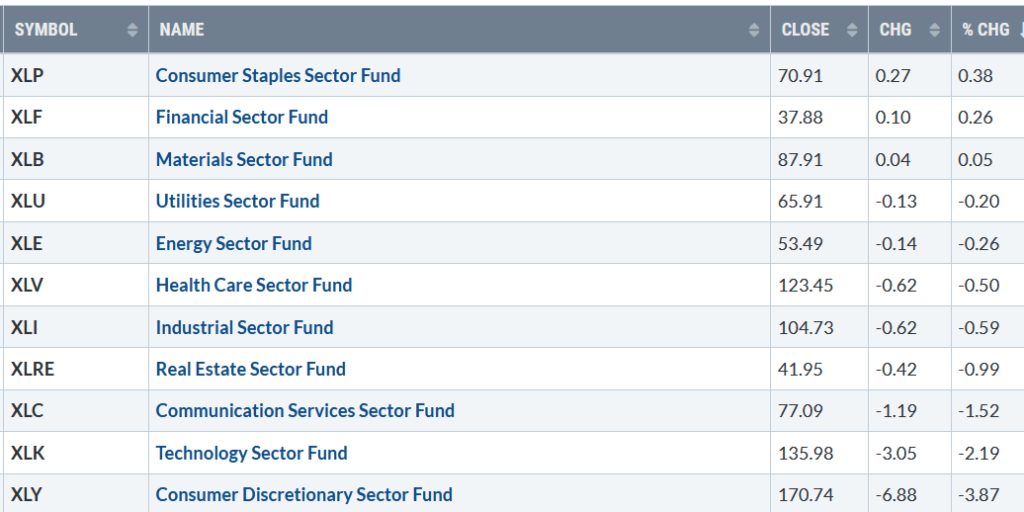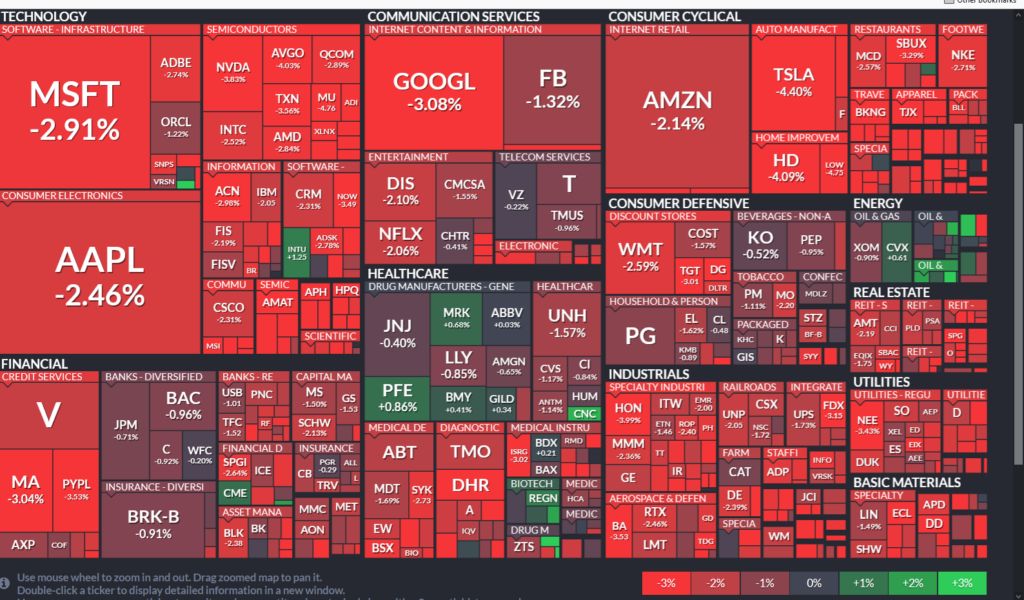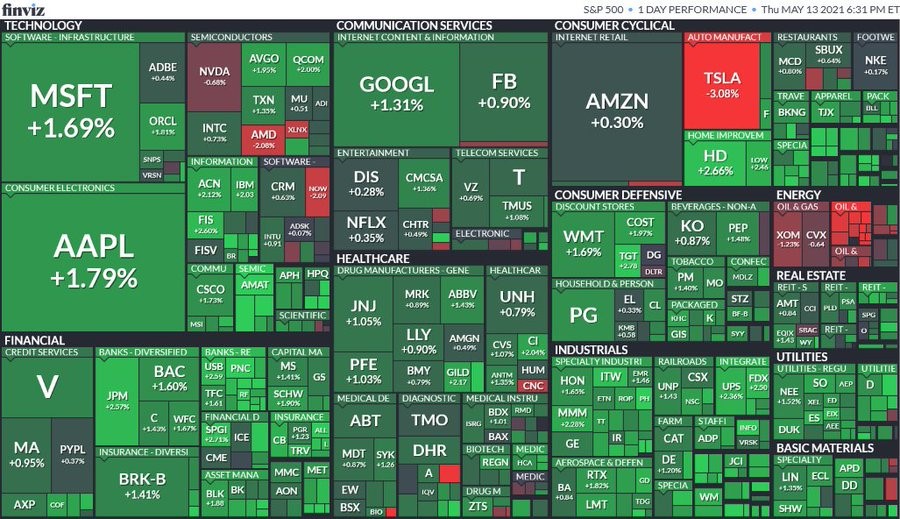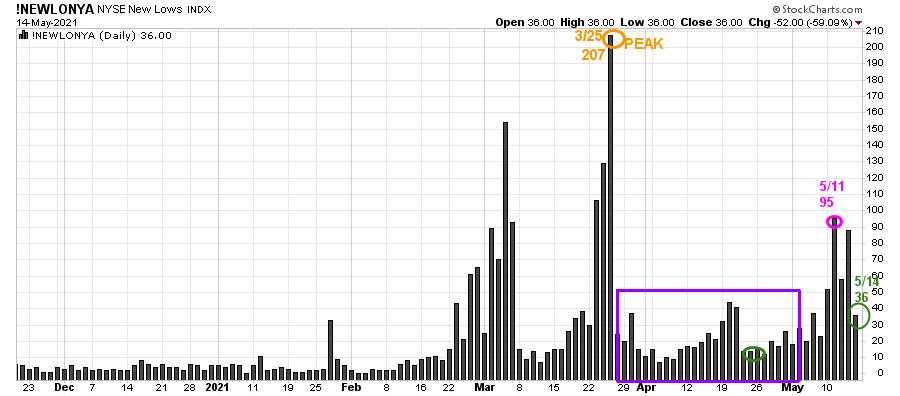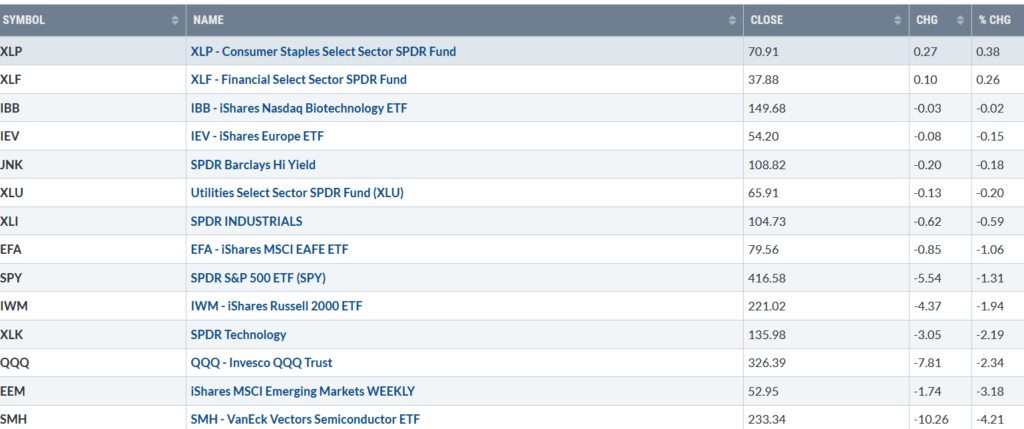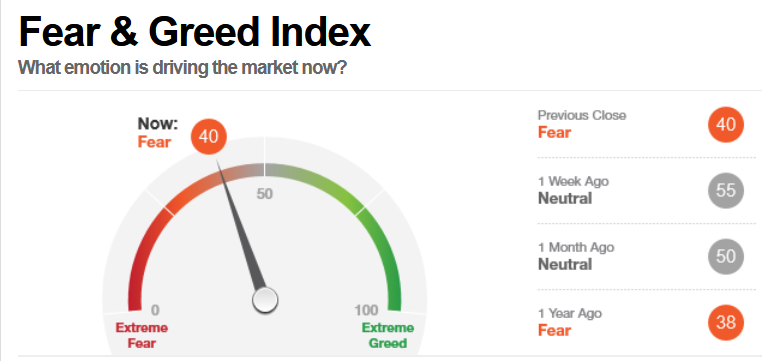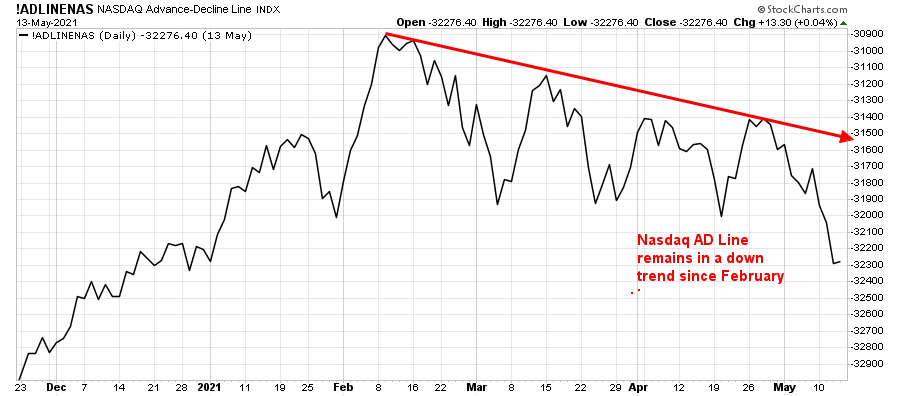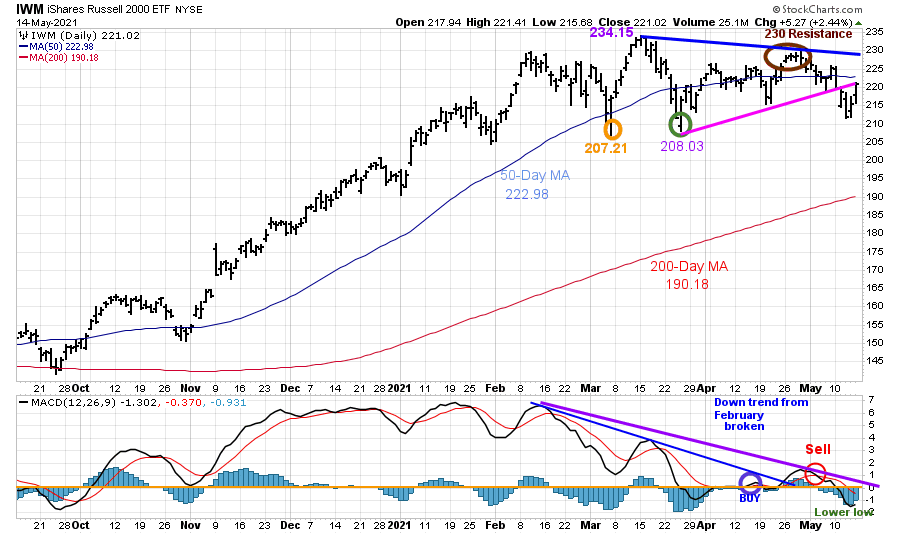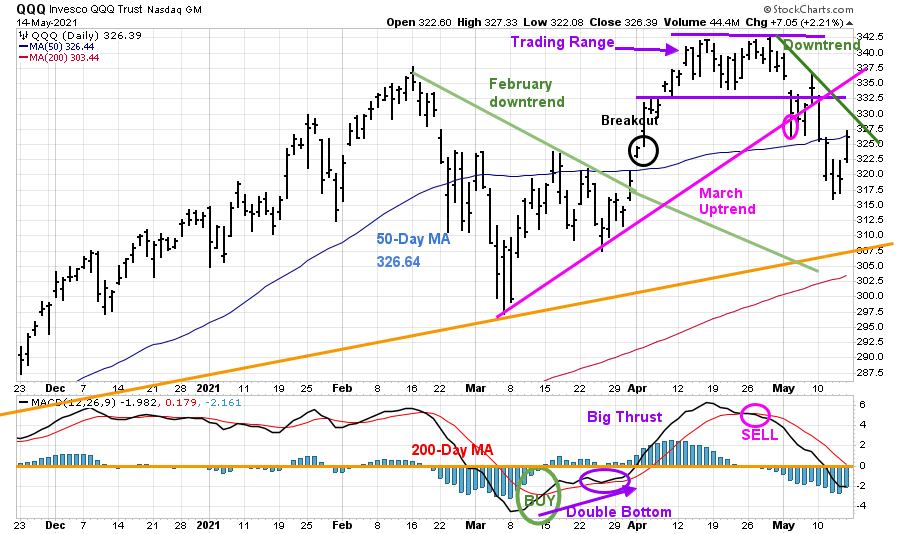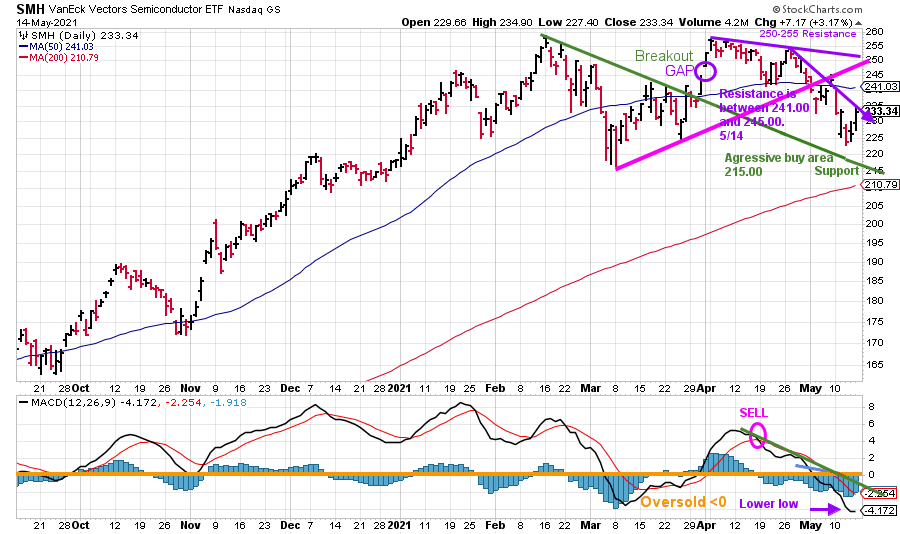Market Wealth Update Week Ending 5/14/21
A volatile week for stocks. Three of the eleven S&P sectors finished higher for the week ending 05/14/21. Consumer Staples and Financials (XLF) rose +0.38%, and +0.26%, respectively. Technology (XLK) and Consumer Discretionary (XLY) were the weakest sectors, down -2.19% and -3.87%. The SPDR S&P 500 ETF Trust (SPY), in comparison, was down -1.31%.
S&P SPDR Sector ETFs Performance Summary
Week Ending 5/14/21
Source: Stockcharts.com
Early last week, sellers were in control. By the end, investors were buying stocks that fell sharply, taking advantage of stocks at bargain prices.
The market averages broke under their trading range, hitting stops under short-term support levels. Heavy selling, a sea of red (Figure 1). An ugly day Wednesday, 5/12, when all 11 S&P sectors were lower. The CBOE Volatility Index (VIX) spiked almost 30% to close at 27.59.
Figure 1: S&P 500 Stocks by Sectors and Industries Wednesday 5/12
Source Finviz.com
Figure 2: S&P 500 Stocks by Sectors and Industries Thursday 5/13
Source Finviz.com
What a difference a day makes. On Thursday, the screen turned to green, investors stepped in to buy, starting to cover their shorts after heavy selling, no follow through to the downside. The CBOE Volatility Index (VIX) fell 16.2% to close at 23.13.
On Friday, major averages followed through to Thursday’s upside reversal, opening strong and closing near its highs. Many didn’t believe Thursday’s rally suspecting it was a dead cat bounce. The CBOE Volatility Index (VIX) dropped further, closing at 18.81, down 18.7%. The Dow finished with its best gain since early March, and the S&P 500 and Nasdaq also had solid gains.
For the week, all major averages were lower. Economic data spooked investors on the concern of inflation. The Dow fell -1.14%, S&P 500 -1.39%, and Nasdaq fell -2.34%, its fourth straight weekly loss. The Russell 2000 index fell -2.07%.
Weekly market breadth is discouraging. The New York Stock Exchange Index had 997 advances and 2496 declines. Nasdaq breadth was negative with 1294 advances and 3152 declines. Market breadth is not as favorable and bears watching. New lows on the NYSE are expanding on down days.
Figure 3: Daily New York Stock Exchange New Lows
Source: Stockcharts.com
On 3/25, the NYSE New Lows peaked at 207 (orange circle) and then immediately contracted (purple rectangle). Watching New lows on the New York Stock exchange is a simple technical tool that helps awareness about the immediate trend’s direction.
In my book, when the New Lows are below 25, the market is very strong (Very Low Risk and prices tend to rise). When New Lows are between 25 and 50, risk is low, and the odds of a further rally are likely.
On 5/11, New lows on New York Stock exchange jumped to 95, their highest level since late March, closing at 36 on 5/14, flashing a warning sign.
If the New Lows are above 50, it is an alert or warning of possible market weakness or a change in the market’s tone. Be aware, it’s a good idea to make sure you are happy and comfortable with your portfolio. It is best not to have volatile investments where you feel uncomfortable because if the selling continues, your losses could build if the market falls further.
It was positive New Lows dropped to 36 On 5/14 to end the week. Continue to monitor the New Lows on the New York Stock Exchange. If New Lows have a succession of days over 95, the 5/11 high will imply that this latest rally is likely to fail, and potentially a more severe correction will occur.
“It’s not how much money you make, but how much money you keep, how hard it works for you, and how many generations you keep it for.” ~ Robert Kiyosaki
Key ETFs to Monitor
Figure 4: Performance week of 5/07-05/14/21
Source: Stockcharts.com
Positives
- Hi-Yield (JNK) and Open-end high yield corporate bond funds were down for the week but remain near their highs.
- Technology stocks (QQQ) rebounded with solid gains, stronger than the S&P 500 on Friday.
- Volume patterns on the Nasdaq are improving, turning up from an oversold level.
- Even with the rally the last two days, market sentiment based on CNN Fear and Greed Index (contrary indicator) closed at 40, showing investors are more nervous now.
Figure 5: CNN Fear and Greed Index
Source: CNN Business
Negatives
- The Nasdaq Advance-Decline Line has not confirmed highs in Nasdaq and remains in a downtrend (Figure 6).
- Russell 2000 (IWM) continues to underperform the S&P 500. MACD closed below its 50-Day MA, below resistance, and made a new low in MACD, which does not bode well for the broad market.
- The short-term hourly momentum oscillators of the major averages are no longer oversold and have overhead resistance above to clear.
- SMH, usually a leader, remains in a downtrend. MACD made a new low, implying downside momentum may not be complete.
Figure 6: The Nasdaq Advance-Decline Line
Source: Stockcharts.com
Watch Russell 2000 (IWM) and Invesco QQQ Trust Nasdaq (QQQ) to determine if the recent rally will be short-lived or further gains will occur.
Figure 7: Daily iShares Russell 2000 (IWM) Price (Top) and 12-26-9 MACD (Bottom)
Source: Stockcharts.com
The top portion of the chart is the daily iShares Russell 2000 Index ETF (IWM), the benchmark for small-cap stocks, with a 50-Day Moving Average (blue line) and 200-Day Moving Average (red line) that traders watch and use to define trends.
IWM made a low on 3/5 at 207.21 (orange circle), then rallied to 234.15 but stalled. On 3/25 successfully tested its low at 208.03 (green circle). IWM then stayed within a range, unable to get through resistance at 230.00 (brown circle) before selling off again.
IWM broke out of its trading range to the downside, closing below support at 215.00, negating the 252.00 upside objective given in the Wealth Market Update 05/07/21.
Last week, after a false breakdown, IWM reversed to the upside to close at 221.02. Even with the strong close, I recommend caution. IWM remains below the uptrend (pink line), and it closed below its 50-Day Moving Average of 222.98. It’s not wise and a higher risk to trade against the trend.
Resistance is at 225.00 followed by 230.00. It would be a positive sign in the short term if IWM can close above 222.98 for two days.
A close above resistance at 230.00 (blue line) would break the March downtrend shifting the trend from down to up, implying further gains. On the other hand, a close below the March low at 207.21 would indicate a more serious decline is likely.
The bottom half of the chart is MACD (12, 26, 9), a measure of momentum. After MACD broke the short-term downtrend from February (blue line), implying downside momentum was complete. There was no thrust to the upside, and MACD gave a sell signal, turning down from above 0.
In Sum
IWM finished the week on a positive note. However, IWM has a pattern of lower highs and lower lows which is not favorable. The short-term trend shifted to down. IWM remains weaker than the S&P 500. MACD also made a new low, implying downside momentum could continue if IWM stalls now and does not close above 230.00 resistance. I recommend waiting for a more optimal buying pattern to develop in three to six weeks for a safer entry.
Figure 8: Daily Invesco QQQ Trust Nasdaq (QQQ) Price (Top) and 12-26-9 MACD Bottom)
Source: Stockcharts.com
The top part of the chart shows the daily Invesco QQQ, an exchange-traded fund based on the Nasdaq 100 Index with its 50-Day Moving Average and 200-Day Moving Average. On 3/31, QQQ broke the downtrend from February (green line) and then gapped higher (black circle), breaking out to the upside. QQQ then stayed within a trading range for three weeks (purple).
On 5/4, QQQ broke the March uptrend (pink circle) but held above its 50-Day MA where the buyers stepped. The rally failed quickly. QQQ reversed lower, turning the short-term trend down.
Short-term resistance is at 330.00, followed by 332.50 and 335.00. A close above 330.00 for two days would be a short-term positive. On the other hand, a close below 307.50 would break the November uptrend (orange line) and imply a more serious decline.
The bottom half of the chart is MACD (12, 26, 9), a measure of momentum. After the March buy (green circle) and big thrust to the upside, MACD gave a quick sell. MACD accelerated to the downside as QQQ fell sharply.
MACD is oversold and below 0. It would be positive if MACD stops falling, showing signs of diminishing downside momentum, and then turns up with QQQ closing above 330.00.
Figure 9: Daily Vaneck Vectors Semiconductor (SMH) Price (Top) and 12-26-9 MACD (Bottom)
Source: Stockcharts.com
The top chart shows Semiconductors (SMH) broke its March downtrend on 3/26 (green line). SMH then gapped up (purple circle), breaking out to a high of 256.68 on 4/8. SMH did not follow through to the upside and had been trending down.
Semiconductors (SMH) fell sharply last week, losing -4.21%. Similar to QQQ and IWM, SMH remains in a downtrend and shows no upside momentum signs.
First support is 225.00, followed by 215.00, an aggressive buy area if SMH turns down early in the week.
Resistance is 235.00, followed by 241.00.
Risk is high until SMH closes above 235.00 and breaks the short-term downtrend. Watch for a pattern to develop with higher lows and the downtrend to be broken for a lower-risk entry.
The lower chart is MACD, a measure of momentum. MACD remains on a sell and continues to make lower lows. MACD is oversold and now below 0. The first sign that downside momentum has slowed is when MACD turns up and then breaks the downtrend (green line).
Update on Speculative Buy Biotechnology (IBB). Risky sectors did not perform well as investors favored defensive sectors. IBB was stopped out at 148.00 as per the Market Wealth Update Week Ending 5/07/21.
Update on iShares Emerging Markets (EEM)
Last week EEM was unable to get through resistance at 55.00, and EEM turned down, breaking the uptrend from March and closing below 52.50, negating the upside projection. For now, until EEM shows better strength and closes above resistance at 55.00, it’s best to avoid EEM. If you want an international investment Europe (IEV) is showing much better relative strength.
Summing Up:
Last week saw significant moves up and down in stocks and the major market averages. Volatility rose sharply and then contracted quickly when there were solid gains to end the week, giving bulls hope that the decline is over and there is more room to the upside. The market closed strong with all 11 S&P sectors higher, led by riskier sectors as the defensive sectors lagged. I’m concerned that even with the gains, riskier sectors that normally lead the overall market higher were some of the weakest sectors for the week and are now in downtrends. If the major averages can follow through on Friday’s rally and close above overhead resistance and break the short-term downtrends, further gains are likely ahead. On the other hand, if there is no follow-through to the upside and the early March lows are violated, then expect day-to-day volatility to increase substantially and a more serious correction to occur. The key closing numbers to watch for a further decline are below 207.21 for IWM and below 307.50 for QQQ.
Remember to manage your risk, and your wealth will grow.
I would love to hear from you. If you have any questions or comments or would like to chat about the market, click here.
If you liked this article, you would love my Free report, Grow and Sustain Your Wealth. Please get it here.
Disclaimer: Although the information is made with a sincere effort for accuracy, it is not guaranteed that the information provided is a statement of fact. Nor can we guarantee the results of following any of the recommendations made herein. Readers are encouraged to meet with their own advisors to consider the suitability of investments for their own particular situations and for determination of their own risk levels. Past performance does not guarantee any future results.


